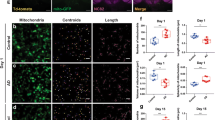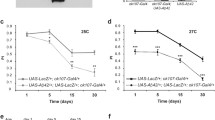Abstract
Molecular mechanisms of the synapse and dendrite integrity maintenance and their disruption in psychiatric and neurodegenerative diseases (NDD) are being studied intensively to identify target genes for therapeutic activities. It is suggested that synapse is a tripartite system in which glia, alongside with well-studied pre- and postsynaptic neurons, represents a third, poorly studied partner in synaptic transmission involved in a positive feedback loop between the other two partners. It is the glia cell-derived neurotrophic factor (GDNF) and the transmembrane proteins, neuregulins, that mediate bidirectional coupling between presynaptic neurons and their postsynaptic targets. Neuregulins are structurally related to the epidermal growth factor and have a cytoplasmic domain that interacts with intracellular LIM kinase 1 (LIMK1), the key enzyme of actin remodeling. Since neurons and axons that do not receive a sufficient GDNF supply are at risk of degeneration and synapse elimination, GDNF became a central target factor in human NDD therapy. The delivery of GDNF-producing stem cells to the nidus of neurodegeneration by transplantation surgery is an efficient tool for NDD treatment. A new approach is proposed based on the use of the Drosophila heat shock (hs) promoter that responds to the mammalian body temperature and ensures constant expression of the human GDNF gene. The Drosophila models facilitate studying the role of each component of the bidirectional signaling between pre- and postsynaptic neurons in the development of the key diagnostic NDD symptom—a defective memory formation resulted from synaptic atrophy. To assess the efficiency of memory formation depending on the level of GDNF and LIMK1 brain expression, we used the Drosophila strains simulating different nervous system disorders: GDNF, the transgenic flies that carry the human GDNF gene under hs-promoter, l(1)ts403, the mutants with disruption of heat shock proteins (HSPs) mRNA nuclear trafficking, and agn ts3 carrying a mutation in LIMK1 gene. We investigated at the behavioral (learning/memory) level the functional connections between GDNF, LIMK1 and HSP signaling transductions that might offer promising targets for complex approaches to NDD treatment.
Similar content being viewed by others
References
Lin, Y.-C. and Koleske, A.J., Mechanisms of Synapse and Dendrite Maintenance and Their GDNFDisruption in Psychiatric and Neurodegenerative Disorders, Respectively, Annu. Rev. Neurosci., 2010, vol. 33, pp. 349–378.
Moises, H.W., Zoega, T., and Gottesman, I.I., The Glial Growth Factors Deficiency and Synaptic Destabilization Hypothesis of Schizophrenia, BMC Psychiat., 2002, vol. 2, no. 8, pp. 1–14.
Ohashi, K., Fujiwara, S., Watanabe, T., Kondo, H., Kiuchi, T., Sato, M., Mizuno, K., Docagne, F., Plawinski, L., MacKenzie, E.T., Vivien, D., and Buisson, A., LIM Kinase Has a Dual Role in Regulating Lamellipodium Extension by Decelerating the Rate of Actin Retrograde Flow and the Rate of Actin Polymerization, J. Biol. Chem., 2011, vol. 286, no. 42, pp. 36 340–36 351.
Slevin, J.T., Gerhardt, G.A., Smith, C.D., Gash, D.M., Kryscio, R., and Young, B., Improvement of Bilateral Motor Functions in Patients with Parkinson Disease through the Unilateral Intraputaminal Infusion of Glial Cell Line-Derived Neurotrophic Factor, J. Neurosurg., 2005, vol. 102, no. 2, pp. 216–222.
Korochkin, L.I., Alexandrova, M.A., Pavlova, G.V., Revischin, A.V., Modestova, E.A., Miroshnikova, O.P., Bragina, T.V., Murkin, E.V., Evgen’ev, M.B., Zelentzova, E.A., Nikitina, E.A., Tokmacheva, E.V., Medvedeva, A.V., Popov, A.V., and Savvateeva-Popova, E.V., Genetic Engineering Methods of the Regulation of Stem Cells Differentiation, Biotechnology and Medicine, New York, USA, 2004, Chapter 16, pp. 119–134.
Korochkin, L.I., New Approaches in Developmental Genetics and Gene Therapy: Xenotransplantation of Drosophila Embryonic Nerve Cells to the Brain of Vertebrates, Genetika, 2000, vol. 36, no. 11, pp. 1436–1442.
Korochkin, L.I., Alexandrova, M.A., Pavlova, G.V., Bashkirov, V.N., Revischin, A.V., Alexenko, O.A., and Evgen’ev, M.B., HSP70 Family Proteins Seem to Facilitate Allo- and Xenotransplantation in the Rat Brain, Tsitologiya, 2002, vol. 44, no. 8, pp. 803–806.
Hidalgo, A., Learte, A.R., McQuilton, P.P., Pennack, J., and Zhu, B., Neurotrophic and Gliatrophic Contexts in Drosophila, Brain Behav. Evol., 2006, vol. 68, pp. 173–180.
Eaton, B.A. and Davis, G.W., LIM Kinase1 Controls Synaptic Stability Downstream of the Type II BMP Receptor, Neuron, 2005, vol. 47, pp. 695–708.
Roos, J.Ch., Sariola, H.V., and Meng, X., Isolation of Drosophila Homolog to Mammalian GDNF, WIPO Patent Application WO/1999/063082, 1999.
Pavlova, G.V., Modestova, E.A., Vengrova, S.P., Efanov, A.A., Rybtzova, N.N., and Korochkin, L.I., Expression of Human gdnf Gene in a Drosophila melanogaster Transgenic Strain, Dokl. Akad. Nauk, 2001, vol. 376, no. 5, pp. 694–696.
Savvateeva, E.V. and Kamyshev, N.G., Behavioral Effects of Temperature Sensitive Mutations Affecting Metabolism of cAMP in D. melanogaster, Pharm. Biochem. Behav., 1981, vol. 14, pp. 603–611.
Medvedeva, A.V., Molotkov, A.V., Nikitina, E.A., Popov, A.A., Karagodin, D.A., Baricheva, E.M., and Savvateeva-Popova, E.V., System Regulation of Genetic and Cytogenetic Processes by the Actin Remodeling Signaling Cascade: Drosophila agnostic Locus, Genetika, 2008, vol. 44, no. 6, pp. 669–681.
Nikitina, E.A., Tokmacheva, E.V., and Savvateeva-Popova, E.V., Heat Shock during Development of Drosophila melanogaster Brain’s Central Structures: Memory Formation in l(1)ts403 Mutant, Genetika, 2003, vol. 39, no. 1, pp. 33–40.
Kamyshev, N.G., Iliadi, K.G., and Bragina, J.V., Drosophila Conditioned Courtship: Two Ways of Testing Memory, Learn. Mem., 1999, vol. 6, pp. 1–20.
Heisenberg, M. and Bohl, K., Isolation of Anatomical Brain Mutants of Drosophila by Histological Means, Z. Naturf., 1979, vol. 34, pp. 134–147.
Saavedra, A., Baltazar, G., and Duarte, E.P., Driving GDNF Expression: The Green and the Red Traffic Lights, Progr. Neurobiol., 2008, vol. 86, pp. 186–215.
Li, R., Soosairajah, J., Harari, D., Citri, A., Price, J., Ng, H.L., Morton, C.J., Parker, M.W., Yarden, Y., and Bernard, O., Hsp90 Increases LIM Kinase Activity by Promoting Its Homodimerization, FASEB J., 2006, vol. 20, pp. E417–E425.
Alfano, L., Guida, T., Provitera, L., Vecchio, G., Billaud, M., Santoro, M., and Carlomagno, F., RET Is a Heat Shock Protein 90 (HSP90) Client Protein and Is Knocked Down upon HSP90, J. Clin. Endocrinol. Metab. Pharmacol. Block, 2010, vol. 95, no. 7, pp. 3552–3557.
Abrescia, C., Sjostrand, D., Kjaer, S., and Ibanez, C.F., Drosophila RET Contains an Active Tyrosine Kinase and Elicits Neurotrophic Activities in Mammalian Cells, FEBS Letters, 2005, vol. 579, pp. 3789–3796.
Pontrello, C.G. and Ethell, I.M., Accelerators, Brakes, and Gears of Actin Dynamics in Dendritic Spines, Open Neurosci. J., 2009, vol. 1, no. 3, pp. 67–86.
Yoong, L.F., Wan, G., and Too, H.P., GDNF-Induced Cell Signaling and Neurite Outgrowths Are Differentially Mediated by GFRalpha1 Isoforms, Mol. Cell. Neurosci., 2009, vol. 41, no. 4, pp. 464–473.
Ng, J., TGF-Beta Signals Regulate Axonal Development through Distinct Smad-Independent Mechanisms, Development, 2008, vol. 135, no. 24, pp. 4025–4035.
Shiryaev, A., Dumitriu, G., and Moens, U., Distinct Roles of MK2 and MK5 in cAMP/PKA- and Stress/p38MAPK-Induced Heat Shock Protein 27 Phosphorylation, J. Mol. Signal., 2011, vol. 6, no. 1, pp. 4–11.
Williams, K.L. and Mearow, K.M., Phosphorylation Status of Heat Shock Protein 27 Influences Neurite Growth in Adult Dorsal Root Ganglion Sensory Neurons in vitro, J. Neurosci. Res., 2011, vol. 89, no. 8, pp. 1160–1172.
Author information
Authors and Affiliations
Corresponding author
Additional information
Original Russian Text © E.A. Nikitina, A.V. Medvedeva, Yu.F. Dolgaya, L.I. Korochkin, G.V. Pavlova, E.V. Savvateeva-Popova, 2012, published in Zhurnal Evolyutsionnoi Biokhimii i Fiziologii, 2012, Vol. 48, No. 6, pp. 588–596.
Rights and permissions
About this article
Cite this article
Nikitina, E.A., Medvedeva, A.V., Dolgaya, Y.F. et al. Involvement of GDNF and LIMK1 and heat shock proteins in drosophila learning and memory formation. J Evol Biochem Phys 48, 529–539 (2012). https://doi.org/10.1134/S0022093012050076
Received:
Published:
Issue Date:
DOI: https://doi.org/10.1134/S0022093012050076




